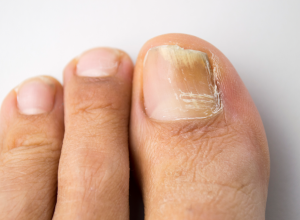
Onycholysis
Onycholysis is the medical term for the painless detachment of the nail from the nail bed. It can happen to both fingernails and toenails and usually affects more than one nail at a time.
Causes
There are many causes of onycholysis, the most common being diseases like psoriasis and onychomycosis (fungal infections). However, chemical exposure (from manicures or pedicures, for example), injury, excessive filing, allergic dermatitis and nail tip application can also cause the nail condition.
In rare cases, medications such as tetracycline, minocycline and oxsoralen can cause onycholysis, as they leave the skin and nails vulnerable to sunburn, which can then lead to the nail condition. Onycholysis can also be caused by an iron deficiency or an over-active thyroid.
Treatment
When faced with onycholysis, dermatologic doctors and medical sites like Medscape and MedicineNet agree that the best way to treat the condition is by trimming the nail short, not cleaning it or exposing the affected nails to water and being patient as the nail grows out. Use gloves when bathing and doing household chores like washing dishes, as it’s important the nail stays dry. Some doctors may prescribe a drying agent such as 3% Thymol in alcohol to be used after washing hands or feet to keep the affected fingernail or toenail completely free of moisture. Nails affected by onycholysis may take several months to grow out. Continue clipping the nail until reattachment is observed.
Notice concerning medical entries:
Articles having medical content shall serve exclusively for the purpose of general information. Such articles are not suitable for any (self-) diagnosis and treatment of individual illnesses and medical indications. In particular, they cannot substitute for the examination, advice, or treatment by a licensed physician or pharmacist. No replies to any individual questions shall be effected through the articles.






